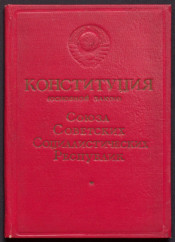
The Presidential Library’s collections present materials about 95 years of the first Constitution of the USSR
January 31, 2019 marks 95 years since the adoption of the first Constitution of the USSR. The portal and the collections of the Presidential Library presented about 200 digital copies of unique documents relating to the development of the Basic Law of our country in various historical periods. These materials from the Archive of the President, the Library of the Presidential Administration and the Constitutional Court of the Russian Federation are collected in the framework of the special collection “The Constitution - The Basic Law”.
A special place in the collection belongs to the Constitution of the USSR in 1924. The Presidential Library’s portal features rare, second edition of the Basic Law, which was released a year after its adoption. The value of this document for national and world history cannot be overestimated. After all, it was it which not only defined the rights and freedoms of Soviet citizens, but also legally designated the emergence of a completely new state - the Union of Soviet Socialist Republics.
The first Constitution of the USSR refers to the state system, which was based on the Soviet power and the dictatorship of the proletariat, emphasizes the multinational character of the newly formed country. At the same time, the right of free withdrawal from the union was reserved for each union republic.
Speaking about the historical “value” of the Basic Law of 1924, it is necessary to mention that it was adopted at a very important moment - two years after the end of the Civil War and 10 days after the death of Vladimir Lenin. The Constitution says that it is only possible to overcome the difficult time and restore the country after a bloody conflict: “The war years did not pass without a trace. The ruined fields, the stopped factories, the destroyed productive forces and the exhausted economic resources inherited from the war make the separate efforts of individual republics for economic construction insufficient. The restoration of the national economy turned out to be impossible with the separate existence of the republics. On the other hand, the instability of the international situation and the danger of new attacks make the creation of a united front of the Soviet republics in the face of the capitalist encirclement inevitable... All these circumstances imperatively require the unification of the Soviet republics into one union state capable of providing external security and domestic economic gains, and freedom of national development of nations".
Considerable attention in the Constitution of the USSR in 1924 is paid to the foreign policy course. Here is what the first section of the Basic Law says: “Since the formation of the Soviet republics, the states of the world have split into two camps: the camp of capitalism and the camp of socialism. There, in the capitalist camp, is national enmity and inequality, colonial slavery and chauvinism, national oppression and pogroms, imperialist atrocities and wars. Here, in the camp of socialism, there is mutual trust and peace, national freedom and equality, peaceful coexistence and fraternal cooperation of the peoples”.
It is important to note that the first Basic Law of the USSR did not simply declare the creation of the country, but derived a vector to the main goal — the spread of Soviet ideology throughout the world: “The new union state will be a worthy cap of the foundations laid back in October 1917... ways of uniting the working people of all countries into the World Socialist Soviet Republic”.
This Constitution defined the life of the Soviet country for 12 years, contributed to the recognition of the USSR as world powers. It was replaced by the Basic Law of 1936, the text of which is also available on the Presidential Library’s portal. This document has set another goal - the construction of socialism.
In late 2018, our country celebrated the 25th anniversary of the Constitution of the Russian Federation. To this date, the Presidential Library presented a number of major projects. In Moscow, at the State Central Museum of Contemporary History of Russia, rare documents on the history of the Basic Law were displayed, which are kept in the Presidential Library. And in the metropolitan park and the largest cultural and educational center “Zaryadie” an exhibition of one exhibit was held, during which the only digital copy of the inaugural copy of the Constitution of the Russian Federation was demonstrated. His Presidential Library was presented personally by the head of state.
The history of the main document of Russia is one of the most important areas of work of the Presidential Library. Multimedia lessons, video lectures, conferences and tours dedicated to the formation of the statehood of our country and the history of its people are regularly held in St. Petersburg, in the building on Senate Square, 3.
Learn more about the development of the Constitution is also possible in the Electronic Museum of the Constitutional History of Russia. Its collections contain video and audio recordings, photographs, digital copies of archival documents, studies, three-dimensional images of authentic artifacts from the XVIII century to the present day.
The digital collections of the Presidential Library number more than 650 thousand copies of rare materials. Full access to them is provided by a wide network of remote access centers, which are located in all 85 regions of Russia and in more than 30 countries of the world. Today their number exceeds 800.

